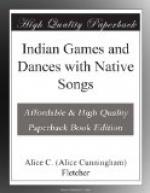The seven leaders, at the beginning of the first line of the second stanza, slowly fall into line and with deliberate rhythmic steps move toward the “field,” reaching it by the fifth line, and while singing that line they should pick up the cornstalks and hold them, with their hands draped with their green mantles, high to the front.
At the close of the first stanza the other group of dancers should resume a dumb show of speaking to one another until the third line of the second stanza, when they change their attitude and give attention; at the fourth line they join in the song, and at the fifth move toward the “field” where are the seven leaders. By the close of the second stanza all the dancers should be in one group at the “field.”
All the dancers stand there at the “field” a moment in silence. Then the seven leaders sing the introduction to the following Processional Song:
Song No. 2
Introduction: Follow Mother Corn,
Who
breathes forth life!
Chorus: H’A-ti-ra, H’A-ti-ra,
H’A-ti-ra, A-ti-ra,
H’A-ti-ra,
A-ti-ra, H’A-ti-ra, A-ti-ra,
A-ti-ra,
H’A-ti-ra, A-ti-ra.
[Music]
This song is retained as sung in the original Pawnee ceremony; the meaning has already been explained.
The introduction is sung by the seven leaders, who advance in two rows, four in the first, three in the second, and in this manner they lead the Processional Dance. At the chorus all the other dancers fall in behind the leaders, either in couples or singly, every one singing. All steps must be rhythmic and in time with the music. The seven leaders move steadily, also in time with the music, as they hold the cornstalks high, while the followers wave their scarfs or mantles and dance happily and lightly, but with dignity. The picture should be one of contrast as the procession takes its way among trees and through the sunny fields, the seven moving evenly, with the corn held high, and the joyous, fluttering group of dancers following.
The Life of the Corn culminates in a delight of color, movement and song.
CALLING THE FLOWERS
INTRODUCTORY NOTE.—This dance is derived from a ceremony, observed among the Indians of the North Pacific Coast, in which the spirits dwelling beneath the ground are called to come and join those who are dancing. The dancer who calls the spirits moves with gliding steps, the arms outstretched, the hands beckoning upward in a gentle, enticing manner. The grace, dignity and earnestness of this dance linger with the writer as a beautiful memory after the lapse of many years.
Properties.—A green scarf for the Caller. Blue, white and rosy scarfs for as many dancers as will personate the three Flowers that respond to the call: Violets, Wild-roses and Daisies. A twisted rope of green to link the dancing Flowers together in the final dance.




